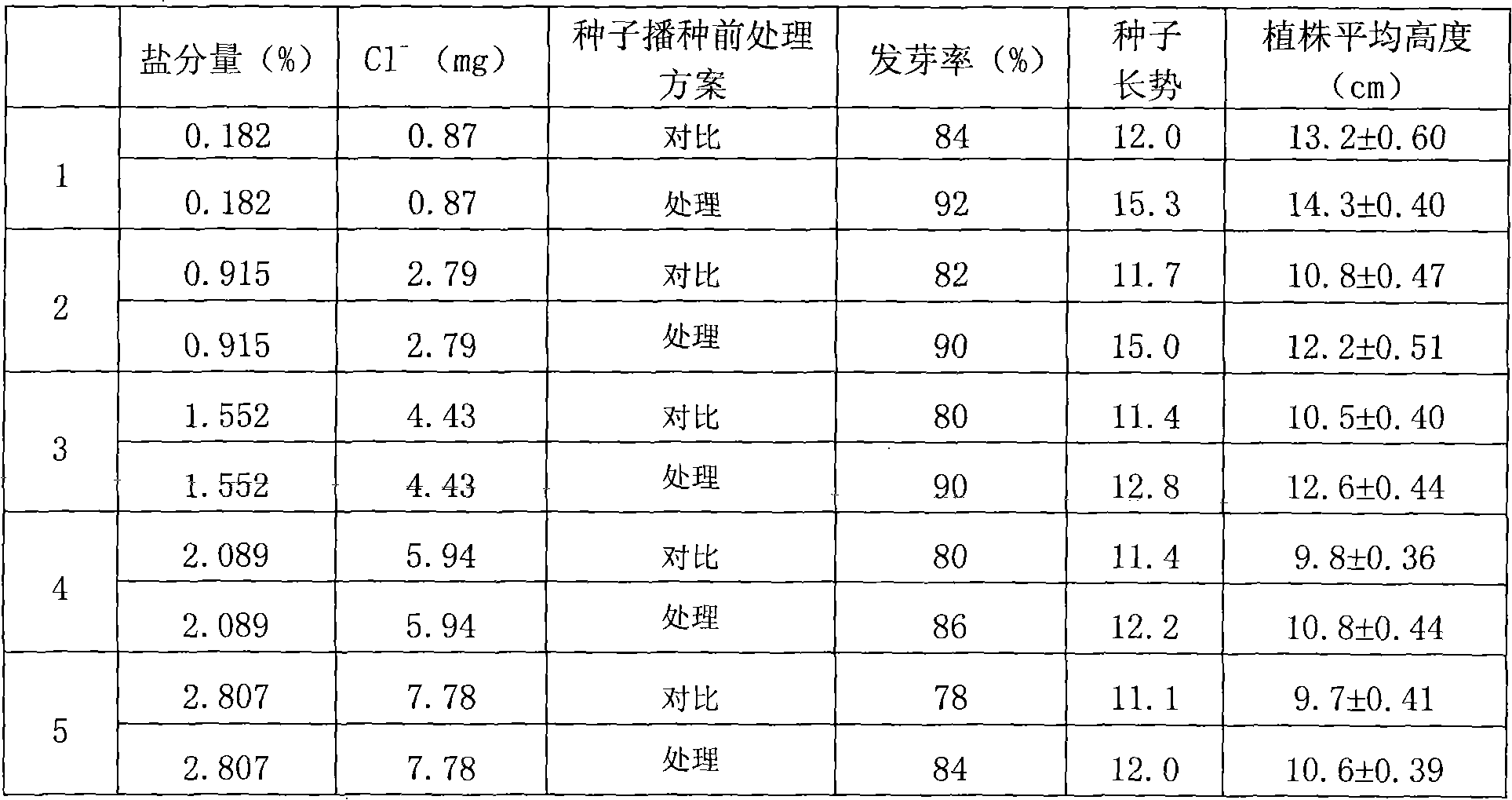Treatment method for improving salt resistance of wheat seeds
A technology of wheat seeds and treatment methods, applied in the fields of seed and rhizome treatment, botany equipment and methods, chemicals for biological control, etc., which can solve the problems of insignificant effect
- Summary
- Abstract
- Description
- Claims
- Application Information
AI Technical Summary
Problems solved by technology
Method used
Image
Examples
Embodiment
[0015] Sodium humate solution (percentage by weight) is prepared in the laboratory: with humic acid 30.0%, sodium 20.0%, total nitrogen 4.0%, phosphorus 0.15%, potassium 0.10%, zinc 0.40%, iron 0.30%, molybdenum 0.21%, Mix 0.06% cobalt, 0.06% copper and the rest of water, stir evenly, and the humidity is 18%;
[0016] a. Soak the winter wheat seeds of variety No. 26 in a 2% sodium humate aqueous solution for 60 minutes, then take out the seeds, and dry them in the air at normal temperature until they are air-dried;
[0017] B, the seed after step a treatment is sown into capacity respectively four times by every kind and is 0.5L, is equipped with meadow-saline-alkali-weak salt light loam (Cl - 0.87mg), meadow-saline-alkali-medium saline light loam (Cl - 2.79mg), meadow-saline-alkali-strong saline light loam (Cl - 4.43-5.94mg) and meadow-saline-alkali-extremely saline light loam (Cl - 7.78mg) in the experimental cups of four kinds of culture medium soil;
[0018] c. Put the...
Embodiment 2
[0021] Sodium humate solution (percentage by weight) is prepared in the laboratory: humic acid 50.0%, sodium 15.0%, total nitrogen 2.0%, phosphorus 0.03%, potassium 0.03%, zinc 0.10%, iron 0.10%, molybdenum 0.05%, cobalt 0.01%, 0.01% copper and the rest of water are mixed, stirred evenly, and the humidity is 20%;
[0022] a. Soak the winter wheat seeds in a 2% sodium humate aqueous solution for 60 minutes, then take out the seeds, and dry them in the air at normal temperature;
[0023] B, the seed after step a treatment is sown into capacity respectively four times by every kind and is 0.5L, is equipped with meadow-saline-alkali-weak salt light loam (Cl - 0.87mg), meadow-saline-alkali-medium saline light loam (Cl - 2.79mg), meadow-saline-alkali-strong saline light loam (Cl - 4.43-5.94mg) and meadow-saline-alkali-extremely saline light loam (Cl - 7.78mg) in the experimental cups of four kinds of culture medium soil;
[0024] c. Put the experimental cup with seeds in step b ...
Embodiment 3
[0027] Sodium humate solution (percentage by weight) is prepared in the laboratory: humic acid 40.0%, sodium 18.0%, total nitrogen 3.0%, phosphorus 0.1%, potassium 0.07%, zinc 0.3, iron 0.20%, molybdenum 0.15%, cobalt 0.03 %, copper 0.03 and water balance are mixed and stirred evenly, and the humidity is 22%;
[0028] a. Soak the winter wheat seeds in a 2% sodium humate aqueous solution for 60 minutes, then take out the seeds, and dry them in the air at normal temperature;
[0029] B, the seed after step a treatment is sown into capacity respectively four times by every kind and is 0.5L, is equipped with meadow-saline-alkali-weak salt light loam (Cl - 0.87mg), meadow-saline-alkali-medium saline light loam (Cl - 2.79mg), meadow-saline-alkali-strong saline light loam (Cl - 4.43-5.94mg) and meadow-saline-alkali-extremely saline light loam (Cl - 7.78mg) in the experimental cups of four kinds of culture medium soil;
[0030] c. Put the experimental cup with seeds in step b into...
PUM
 Login to View More
Login to View More Abstract
Description
Claims
Application Information
 Login to View More
Login to View More - R&D
- Intellectual Property
- Life Sciences
- Materials
- Tech Scout
- Unparalleled Data Quality
- Higher Quality Content
- 60% Fewer Hallucinations
Browse by: Latest US Patents, China's latest patents, Technical Efficacy Thesaurus, Application Domain, Technology Topic, Popular Technical Reports.
© 2025 PatSnap. All rights reserved.Legal|Privacy policy|Modern Slavery Act Transparency Statement|Sitemap|About US| Contact US: help@patsnap.com

